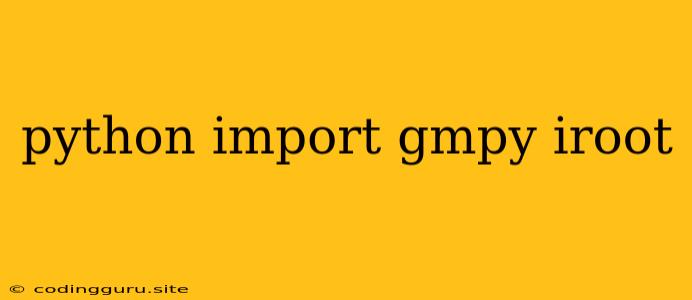Unlocking the Power of Integer Roots with gmpy in Python
Python's standard library is incredibly robust, but for more advanced mathematical operations, you often need the help of external libraries. When it comes to efficiently calculating integer roots, the gmpy library shines.
Why Use gmpy?
Python's built-in math module provides functions like sqrt for square roots. But what if you need to find the cube root, fifth root, or any other integer root of a number? That's where gmpy comes in.
Importing gmpy
The first step is to import the gmpy library into your Python script. Here's how:
import gmpy2
The iroot Function
The gmpy2 library offers the iroot function, which is a powerful tool for calculating integer roots.
Understanding the iroot Function
The iroot function takes two arguments:
- The number: This is the value for which you want to find the root.
- The root index: This indicates the degree of the root. For example, 2 for square root, 3 for cube root, and so on.
Example: Calculating Cube Root
Let's say you want to find the cube root of 27:
import gmpy2
number = 27
root_index = 3
result = gmpy2.iroot(number, root_index)
print(result)
# Output: (mpz(3), True)
The output (mpz(3), True) reveals two important pieces of information:
mpz(3): This indicates the integer root, which is 3 in this case.True: This signifies that the result is an exact integer root.
Handling Non-Integer Roots
If the number doesn't have an exact integer root for the given index, the iroot function still provides a useful output. It returns the closest integer root along with a False value to indicate that the root is not exact.
Example: Non-Integer Root
Let's try finding the cube root of 20:
import gmpy2
number = 20
root_index = 3
result = gmpy2.iroot(number, root_index)
print(result)
# Output: (mpz(2), False)
Here, the output (mpz(2), False) tells us that the closest integer root of 20 to the power of 3 is 2, but it's not an exact root.
Additional Notes
- The
gmpy2.irootfunction works efficiently with large numbers, even for high-degree roots. - If you only need to calculate square roots, the built-in
math.sqrtfunction is generally faster and more convenient. - For applications involving arbitrary precision calculations,
gmpy2offers thempfrtype, which supports floating-point arithmetic with arbitrary precision.
In Summary
The gmpy2 library is a valuable tool for efficient integer root calculations in Python. It provides the iroot function that simplifies finding integer roots of any degree. Whether you need exact integer roots or the closest integer approximation, gmpy2 provides a straightforward and powerful solution.
